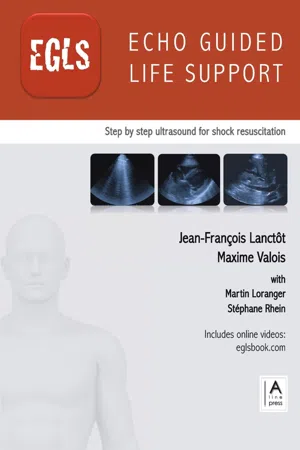
Echo Guided Life Support (EGLS)
- English
- ePUB (mobile friendly)
- Available on iOS & Android
Echo Guided Life Support (EGLS)
About this book
The EGLS algorithm is a simple and effective framework designed to guide clinicians in the management of shockpatients.
Over the last decade, bedside ultrasound has gained widespread acceptance and is now considered standard of care in many clinical situations. With appropriate use, ultrasound can decrease the time to diagnosis and narrow the list of differential diagnosis, two factors essential in the treatment of trauma or hemodynamic instability.
An ultrasound assessment is particularly useful for managing a patient in undifferentiated shock. This book describes how and why an ultrasound assessment called the EGLS algorithm can be an essential tool for managing this time sensitive morbid condition.
Section 1 (Physics and Instrumentation) of this book addresses basic concepts such as the physics of ultrasound and the use of sonographic equipment.
Section 2 (Image Acquisition and Interpretation) provides essential information regarding image acquisition and interpretation in the context of hemodynamic instability. A systematic, step by step approach to image acquisition and interpretation is described for lung, cardiac, and IVC ultrasound with a summary of common tips and pitfalls.
Section 3 (Putting It All Together) combines lung, cardiac, and IVC ultrasound with the ‘sonographic physiology 101’ of shock. This section describes how ultrasound can help determine a patient’s physiology and estimate their fluid responsiveness. The book closes with a collection of common clinical scenarios to summarize how shock can be efficiently managed with the EGLS algorithm.
Frequently asked questions
- Essential is ideal for learners and professionals who enjoy exploring a wide range of subjects. Access the Essential Library with 800,000+ trusted titles and best-sellers across business, personal growth, and the humanities. Includes unlimited reading time and Standard Read Aloud voice.
- Complete: Perfect for advanced learners and researchers needing full, unrestricted access. Unlock 1.4M+ books across hundreds of subjects, including academic and specialized titles. The Complete Plan also includes advanced features like Premium Read Aloud and Research Assistant.
Please note we cannot support devices running on iOS 13 and Android 7 or earlier. Learn more about using the app.
Information



Table of contents
- Cover
- Title Page
- Copyright Page
- Preface
- About the Authors
- Dedication
- Contents
- Section 1: Physics and Instrumentation
- Section 2: Image Acquisition and Interpretation
- Section 3: Putting It All Together
- Conclusion
- Index
- Notes